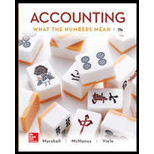
1.
Concept Introduction:
Contribution Margin-
Contribution margin can be defined as the difference between sales and variable costs. The portion i.e. left after deducting variable costs of the product from the sales, it is termed as contribution margin.
Contribution margin is a cost accounting concept which helps company to identify the profit earned on a single product.
It is measured by deducting variable costs from selling price.
Contribution margin ratio:
Contribution margin is the difference between sales and the variable cost. Contribution margin ratio can be defined as the difference between sales and variable cost expressed as the percentage of sales.
Variable costs:
Variable costs can be defined the cost or the expenses that change with the change in the level of output.
Fixed costs:
Fixed costs can be defined as the cost or the expenses that do not change with the change in the level of output.
To calculate:
Missing amounts for Firm A
2.
Concept Introduction:
Contribution Margin-
Contribution margin can be defined as the difference between sales and variable costs. The portion i.e. left after deducting variable costs of the product from the sales, it is termed as contribution margin.
Contribution margin is a cost accounting concept which helps company to identify the profit earned on a single product.
It is measured by deducting variable costs from selling price.
Contribution margin ratio:
Contribution margin is the difference between sales and the variable cost. Contribution margin ratio can be defined as the difference between sales and variable cost expressed as the percentage of sales.
Variable costs:
Variable costs can be defined the cost or the expenses that change with the change in the level of output.
Fixed costs:
Fixed costs can be defined as the cost or the expenses that do not change with the change in the level of output.
To calculate : Missing amounts for Firm B
3.
Concept Introduction:
Contribution Margin-
Contribution margin can be defined as the difference between sales and variable costs. The portion i.e. left after deducting variable costs of the product from the sales, it is termed as contribution margin.
Contribution margin is a cost accounting concept which helps company to identify the profit earned on a single product.
It is measured by deducting variable costs from selling price.
Contribution margin ratio:
Contribution margin is the difference between sales and the variable cost. Contribution margin ratio can be defined as the difference between sales and variable cost expressed as the percentage of sales.
Variable costs:
Variable costs can be defined the cost or the expenses that change with the change in the level of output.
Fixed costs:
Fixed costs can be defined as the cost or the expenses that do not change with the change in the level of output.
To calculate:
Missing amounts for Firm C
4.
Concept Introduction:
Contribution Margin-
Contribution margin can be defined as the difference between sales and variable costs. The portion i.e. left after deducting variable costs of the product from the sales, it is termed as contribution margin.
Contribution margin is a cost accounting concept which helps company to identify the profit earned on a single product.
It is measured by deducting variable costs from selling price.
Contribution margin ratio:
Contribution margin is the difference between sales and the variable cost. Contribution margin ratio can be defined as the difference between sales and variable cost expressed as the percentage of sales.
Variable costs:
Variable costs can be defined the cost or the expenses that change with the change in the level of output.
Fixed costs:
Fixed costs can be defined as the cost or the expenses that do not change with the change in the level of output.
To calculate:
Missing amounts for Firm C
Want to see the full answer?
Check out a sample textbook solution
Chapter 12 Solutions
Accounting: What the Numbers Mean

 AccountingAccountingISBN:9781337272094Author:WARREN, Carl S., Reeve, James M., Duchac, Jonathan E.Publisher:Cengage Learning,
AccountingAccountingISBN:9781337272094Author:WARREN, Carl S., Reeve, James M., Duchac, Jonathan E.Publisher:Cengage Learning, Accounting Information SystemsAccountingISBN:9781337619202Author:Hall, James A.Publisher:Cengage Learning,
Accounting Information SystemsAccountingISBN:9781337619202Author:Hall, James A.Publisher:Cengage Learning, Horngren's Cost Accounting: A Managerial Emphasis...AccountingISBN:9780134475585Author:Srikant M. Datar, Madhav V. RajanPublisher:PEARSON
Horngren's Cost Accounting: A Managerial Emphasis...AccountingISBN:9780134475585Author:Srikant M. Datar, Madhav V. RajanPublisher:PEARSON Intermediate AccountingAccountingISBN:9781259722660Author:J. David Spiceland, Mark W. Nelson, Wayne M ThomasPublisher:McGraw-Hill Education
Intermediate AccountingAccountingISBN:9781259722660Author:J. David Spiceland, Mark W. Nelson, Wayne M ThomasPublisher:McGraw-Hill Education Financial and Managerial AccountingAccountingISBN:9781259726705Author:John J Wild, Ken W. Shaw, Barbara Chiappetta Fundamental Accounting PrinciplesPublisher:McGraw-Hill Education
Financial and Managerial AccountingAccountingISBN:9781259726705Author:John J Wild, Ken W. Shaw, Barbara Chiappetta Fundamental Accounting PrinciplesPublisher:McGraw-Hill Education





